
You can use various tools to rename multiple files on Windows 10, and here's how.
When you purchase through links on our site, we may earn an affiliate commission. Here’s how it works.

On Windows 10, changing the name of one file is easy. The problem is when you must rename many files in a specific folder, but don't worry. In this guide, I'll outline the steps to complete this task.
If you have to rename a long list of files, it's possible to speed up the process using File Explorer, PowerShell, Command Prompt, and even the Microsoft PowerToys app.
In this guide, I'll walk you through several ways to bulk rename files, including changing the extension.
The simplest way to rename one or multiple files on Windows 10 is through File Explorer.
To rename multiple files with the "Tab" key, use these steps:
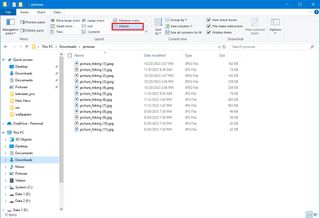
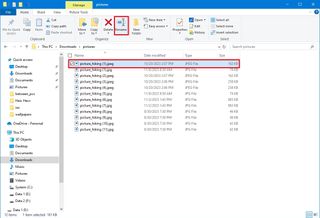
Once you complete these steps, keep pressing the "Tab" key to continue renaming files in the location.
To rename multiple files in bulk with the same name structure on Windows 10, use these steps:
All the latest news, reviews, and guides for Windows and Xbox diehards.
By submitting your information you agree to the Terms & Conditions and Privacy Policy and are aged 16 or over.

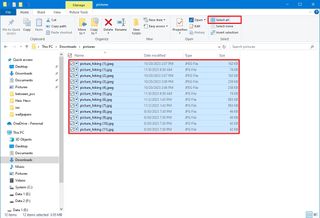
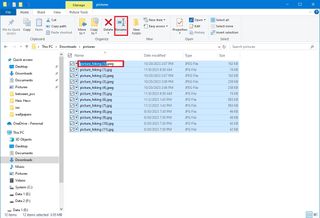
After you complete the steps, the selected files will be renamed using the same naming structure you specified, with a count number in parentheses to make each file name different. For example, "summer_trip_2023 (1).jpg" and "summer_trip_2023 (2).jpg."
You could use the "Ctrl + Z" keyboard shortcut to undo the changes if you made a mistake, or click the menu button from the title bar and select the "Undo" button.
Command Prompt also offers multiple ways to change the name of multiple files in bulk on Windows 10.
To rename one file with Command Prompt on Windows 10, use these steps:
For instance, this example opens the "rename" folder inside "Pictures": cd %USERPROFILE%\Pictures\rename
In the command, replace "OLD-FILENAME.EXTENSION" and "NEW-FILENAME.EXTENSION" with the old and new file names. The quotation marks are only necessary if the title includes spaces. For instance, this command renames the file to "summer_trip_23_notes.txt": ren summer_trip_23_notes.txt summer_vacation_23_notes.txt
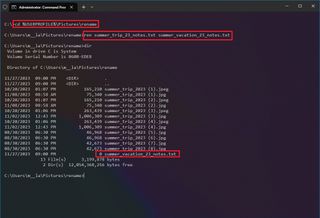
Once you complete these steps, Command Prompt will rename the file with the new name.
To rename multiple files in bulk with the same name structure with Command Prompt, use these steps:
For example, this example opens the "rename" folder inside "Pictures": cd %USERPROFILE%\Pictures\rename
In the command, replace "FILE-EXTENSION" with the extension to change and "FILE-NAME" with part of the name to add to the files. The asterisk (*) is a wildcard that tells the ren command to rename everything with a specific extension. The question mark (?) is also a wildcard, but it represents a character of the original name you want to keep as part of the new name. For example, this command renames all ".jpg" files, leaving the first three characters (which works as a unique identifier to avoid duplication), and appends "-Camping-Trip" to the name: ren *.jpg . -Camping-Trip.*
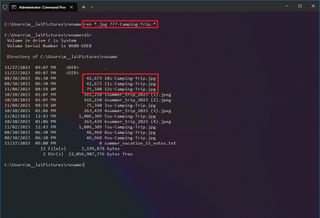
After you complete the steps, the files will be renamed using the settings you specified.
To make file names shorter with Command Prompt on Windows 10, use these steps:
This example opens the "rename" folder inside "Pictures": cd %USERPROFILE%\Pictures\rename
In the command, the asterisk (*) matches all the file names and extensions in the folder, and the question marks (?) indicate how many characters to use for the new file name. For instance, this command trims the file names longer than five characters: ren *.* . *
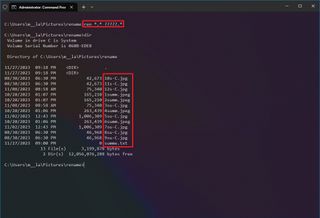
Once you complete these steps, the command will run and shorten the file name, depending on the question marks (?) available in the command.
To rename part of the name on similar files on Windows 10, use these steps:
This example opens the "rename" folder inside "Pictures": cd %USERPROFILE%\Pictures\rename
In the command, replace "OLD-FILE-NAME-PART" and "NEW-FILENAME-PART" with the old and new parts of the filename. The asterisk (*) is a wildcard that will match the rest of the filename and file extension to append the new part of the name. For instance, this command renames files that start with "summer_trip_23" to "vacation_2023": ren summer_trip_23*.* vacation_2023*.*
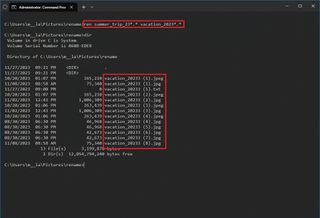
After you complete the steps, the command will modify those files like the new name structure available in the command.
Change file extension
To change the file extension to another, use these steps:
This example opens the "rename" folder inside "Pictures": cd %USERPROFILE%\Pictures\rename
In the command, change "OLD-EXTENSION" and "NEW-EXTENSION" with the old and new file extensions. For example, this command changes the extension from ".txt" to ".doc" compatible with Microsoft Word for the files in the location: ren *.txt *.doc
This example without wildcards (*) changes the only extension of a single file from ".txt" to ".doc": ren vacation_2023_notes.txt vacation_2023_notes.doc
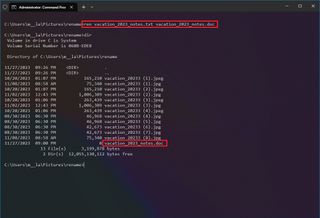
Once you complete the steps, the file extension will be changed to the new extension in the command.
The previous steps rename every file within the location. However, if you want to rename only a group of files with a specific format, you must omit the asterisk (*) and specify the command's target extension.
To rename files with a specific file extension with Command Prompt, use these steps:
This example opens the "rename" folder inside "Pictures": cd %USERPROFILE%\Pictures\rename
In the command, change "OLD-FILE-NAME," "NEW-FILE-NAME," and "EXTENSION" with the old and new file name and extension. For instance, this command only renames images with a ".jpg" extension: ren picture-*.jpg vacation*.jpg
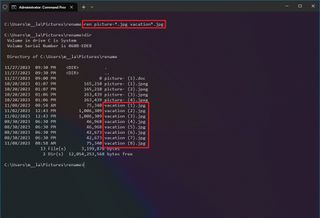
After you complete the steps, Command Prompt will rename the files using the specified options.
You can also use PowerShell to rename multiple files on Windows 10. Although you have many ways to manipulate files using this tool, the instructions in this guide are only meant to get started with the most common scenarios.
To rename only one file with a PowerShell command, use these steps:
In the command, replace "PATH\TO\FOLDER" with the actual path to the location. For example, this command navigates the "rename" folder inside "Pictures": cd C:\Users\USERNAME\Pictures\rename
In the command, specify the old and new file names and extensions. The quotation marks are only required if the name includes spaces. For instance, this command renames the file to "hiking_trip_2023_notes.txt": Rename-Item summer_trip_23_notes.txt hiking_trip_2023_notes.txt
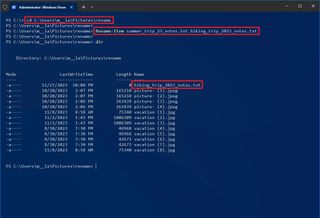
Once you complete the steps, the command will change the specified file name.
To rename multiple files in bulk when the name structure is not important, use these steps:
In the command, replace "PATH\TO\FOLDER" with the actual path to the location. For example, this command navigates the "rename" folder inside "Pictures": cd C:\Users\USERNAME\Pictures\rename
In the command, replace "NEW-FILE-NAME" with the structure name you want to use. For example, this command renames images with a ".jpg" extension using the same ("beach-trip-2023-") naming structure and appends a different number at the end of the name: ls | %.jpg" -f $nr++)>
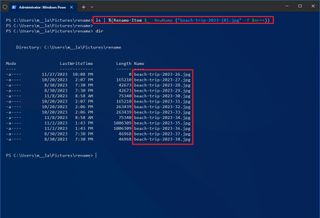
After you complete these steps, the files with the specified format will be renamed using the structure available with the command.
To make file names shorter or trim part of the names by an "N" number of characters, use these steps:
In the command, replace "PATH\TO\FOLDER" with the actual path to the location. For example, this command navigates the "rename" folder inside "Pictures": cd C:\Users\USERNAME\Pictures\rename
In the command, inside "$_.BaseName.length-N" update the value of "N" to specify the number of characters to remove. For instance, this command trims the name of your files by eight characters: ls | Rename-Item -NewName
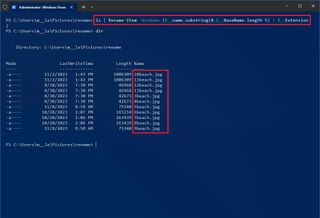
Once you complete these steps, the files in the location will have shorter names (right to left), depending on the specified length.
Delete part of the name from multiple files
To remove part of the file name on multiple files with PowerShell commands, use these steps:
In the command, replace "PATH\TO\FOLDER" with the actual path to the location. For example, this command navigates the "rename" folder inside "Pictures": cd C:\Users\USERNAME\Pictures\rename
In the command, replace "OLD-FILE-NAME-PART" with the actual part of the name you want to replace. For instance, this command removes the word "trip" from the name of all files in the folder: ls | Rename-Item -NewName

After you complete the steps, the command will remove the file name part as specified in the command.
To rename the same part of the file name, use these steps:
In the command, replace "PATH\TO\FOLDER" with the actual path to the location. For example, this command navigates the "rename" folder inside "Pictures": cd C:\Users\USERNAME\Pictures\rename
In the command, replace "OLD-FILE-NAME-PART" and "NEW-FILE-NAME-PART" with the old and new parts of the file name. For example, this command replaces the word "vacation_" for "camping_trip_" in the file name: ls | Rename-Item -NewName vacation_","camping_trip_">
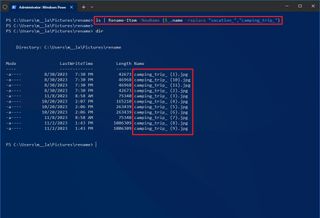
Once you complete these steps, the command will modify the file names with the replacement you specified in the command.
The space character as part of the file name can sometimes cause problems, even more so when using commands. If you have files with spaces in their names, you can use PowerShell to replace the character for a visual separator, such as a dash or underscore symbol.
To remove and replace spaces with underscores in filenames with PowerShell, use these steps:
In the command, replace "PATH\TO\FOLDER" with the actual path to the location. For example, this command navigates the "rename" folder inside "Pictures": cd C:\Users\USERNAME\Pictures\rename
In the command, make sure to replace "SEPARATOR" with the symbol instead of a space. For instance, this command replaces spaces with underscores in the files: ls | Rename-Item -NewName
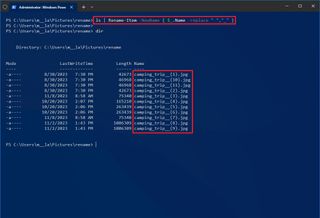
After you complete the steps, the spaces will be replaced with the separator indicated in the command.
To change the file extension for a bunch of files with PowerShell, use these steps:
In the command, replace "PATH\TO\FOLDER" with the actual path to the location. For example, this command navigates the "rename" folder inside "Pictures": cd C:\Users\USERNAME\Pictures\rename
In the command, replace ".NEW-EXTENSION" with a new file extension. For instance, this command changes any file extension to ".doc": ls | Rename-Item -NewName

Once you complete the steps, PowerShell will change the extension for the files in the folder location.
The above instructions will rename every file within the folder. However, if you want to change the name of a specific file format, such as documents, pictures, or videos, you can use the "-filter" option.
To change the names of a specific file format with PowerShell commands on Windows 10, use these steps:
In the command, replace "PATH\TO\FOLDER" with the actual path to the location. For example, this command navigates the "rename" folder inside "Pictures": cd C:\Users\USERNAME\Pictures\rename
In the command, replace "NEW-FILE-NAME" and "EXTENSION" with the new parameter. For instance, this command renames only files that include the ".doc" extension: ls -filter *.doc | %.doc" -f $nr++)>
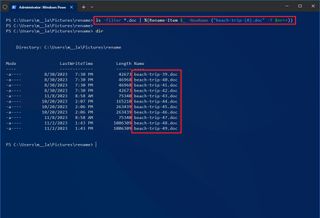
Once you complete the steps, PowerShell will rename the files with a specific extension specified in the command.
While these commands have been tested to work as expected, it is always recommended that you perform a test run before renaming the original files on your computer.
On Windows 10, PowerToys is an advanced tool that adds many helpful productivity tools, including "PowerRename," which makes it easier to bulk rename files without using commands.
To install PowerToys on Windows 10, use these steps:
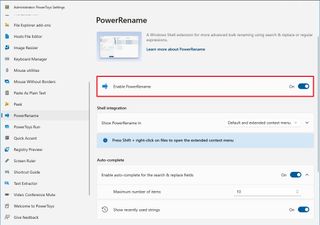
After you complete the steps, you can start using the tool to rename multiple files.
To rename or replace part of the name of multiple files, use these steps:
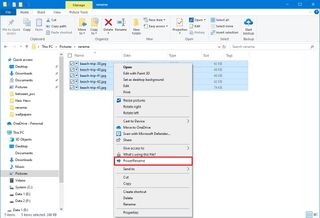
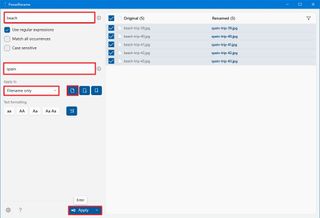
Once you complete the steps, the files will be renamed according to your configuration.
To rename all the files without a common structure, use the steps:
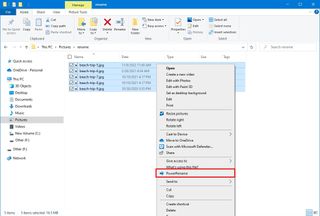
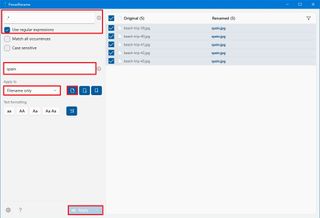
After you complete the steps, all the files in the list will be renamed to the base name you assigned them.
To append a description to the file name, use the steps:


To change the file extension of multiple files with PowerToys, use these steps:

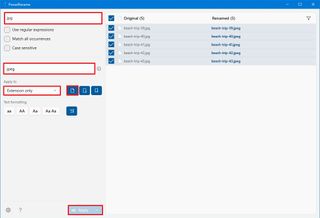
Once you complete the steps, the file extension will change to the one you specified.
PowerToys PowerRename is a powerful tool that lets you manipulate file names virtually in any way you want using regular expressions. You can learn more about the options available to create patterns to rename files in this Microsoft documentation page.
For more helpful articles, coverage, and answers to common questions about Windows 10 and Windows 11, visit the following resources: